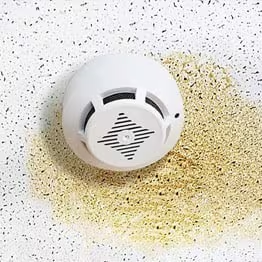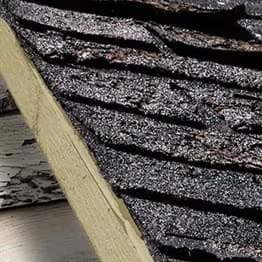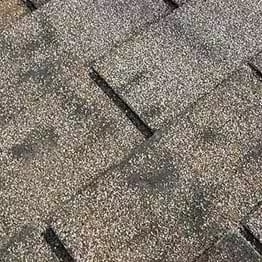How to Recognize Roof Damage and Know Whether You Need Repairs or a Replacement….
Repair or Replace?
If your roof is relatively new and you’re only seeing a few damaged or loose shingles, a simple repair might be enough. But if the damage is more widespread, it may be time to consider a full roof replacement. The best way to stay on top of your roof’s condition is with regular inspections.
What Does Roof Damage Look Like?

Attic Leaks
After a storm, inspect your attic for signs of water infiltration. Leaks could point to damaged shingles, failed underlayment (the protective layer between the shingles and roof deck), or deteriorated flashing (material that seals roof joints).

Blistering or Peeling Paint
Poor attic ventilation can cause moisture to build up inside your home, leading to exterior paint that blisters or peels.

Stains on Ceilings and Walls
Water leaks from the roof—or trapped moisture inside your home—can create noticeable stains. These spots may also lead to mold or mildew over time.

Sheathing (Decking) Decay
Excess moisture can cause the plywood layer beneath your roofing materials, known as sheathing or decking, to deteriorate. Sagging ceilings, broken gutters, and missing shingles are all red flags that your roof’s foundation might be compromised.

Damaged Shingles
Shingles that are curled, cracked, brittle, or missing altogether likely indicate they’ve reached the end of their life. This is a strong sign it’s time for a new roof.

Dark Streaks
What looks like dirt could actually be moss, algae, or lichen. These don’t necessarily mean you need a new roof immediately, but when the time comes to replace it, consider shingles with built-in StainGuard® or StainGuard® Plus protection to prevent future streaks.
How to Inspect Your Roof
Conducting routine inspections—especially after extreme weather—can help catch problems early and avoid more serious damage.
Start Inside
-
Head to the attic and check for signs of leaks, dark patches, holes, or sagging wood.
-
Look at ceilings throughout your home for signs of water stains, mold, or mildew.
Step Outside
-
If you’re comfortable with heights, use a ladder for a closer look. Otherwise, binoculars from the ground can help.
-
Clean out gutters and downspouts. Look for sagging or leaks.
-
Check under eaves and fascia boards for rot or pest damage.
From the Street
-
Look for dark patches, sagging areas, or visibly missing shingles.
-
Blistering or peeling exterior paint may also signal trapped moisture from roof issues.
-
In winter, keep an eye out for ice dams—ridges of ice at the roof edge that block proper drainage and can lead to interior leaks.
Examine the Roof Surface
-
Inspect for cracked, curling, or missing shingles.
-
Check nails—are they popping out or rusted?
-
Look for open seams, exposed joints, or clogged vents.
-
Ensure all flashing is secure and sealing joints properly.
-
Examine chimneys, skylights, and roof vents to ensure they’re sealed and watertight.
Ongoing Roof Maintenance Tips
-
Know your roof’s age. If you didn’t install it, refer to the inspection report from your home purchase or have a roofing contractor evaluate it.
-
Do a visual check at least twice a year—in spring and fall.
-
After any major weather event, inspect the roof for damage as soon as it’s safe.
-
Watch the neighborhood—if nearby homes are getting new roofs, it could be a sign that your own may be due soon too.
-
Not sure what you’re looking for or feel unsafe doing it yourself? Contact a certified roofing professional for a proper inspection.







